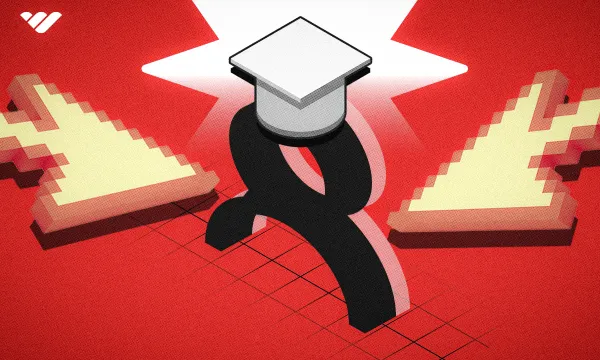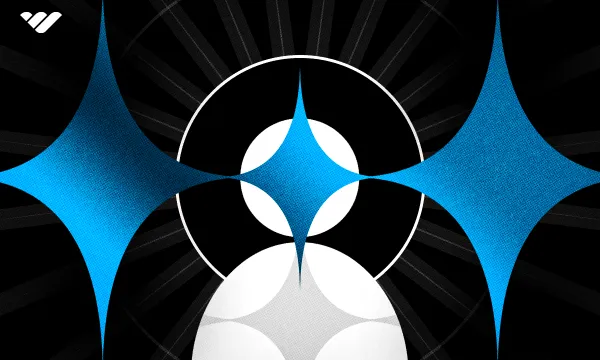The Milk Road newsletter went from $0 to $1 million in annual recurring revenue in just six months. Software and work culture newsletter, Refactoring, brings in $300,000 a year. With 90% of Americans subscribed to at least one email list, newsletters are becoming an increasingly common way for creators to make money.
My newsletter isn’t quite at the same level as these pioneers, but with 5,000+ subscribers I can make anywhere from $100-$500 per newsletter selling ad spots and digital products. At first, I was cautious about selling ad space for fear my loyal subscribers would think I’d “sold out”, but it turns out consumers are open to ads.
According to MarketingTech, consumers don’t mind seeing ads as long as they’re relevant or provide something of value. In fact, when asked about advertising in email newsletters, 64% of respondents said they’d click on an ad that aligns with their interests. But ads aren’t the only way to monetize your newsletter.
How Do Newsletters Make Money?
There’s no one-size-fits-all way to make money with a newsletter. From affiliate links and donations to paid memberships and sponsors, here are some of the most common ways newsletters generate revenue.
1. Tip Jars and Donations
Asking for donations is a low-effort way to make money from your newsletter. Encourage subscribers to buy you a coffee, send a one-off payment, or donate every month to cover the costs of creating the newsletter.
The Rarely Certain newsletter invites loyal subscribers to tip creator, Mike, through the Buy Me a Coffee app.
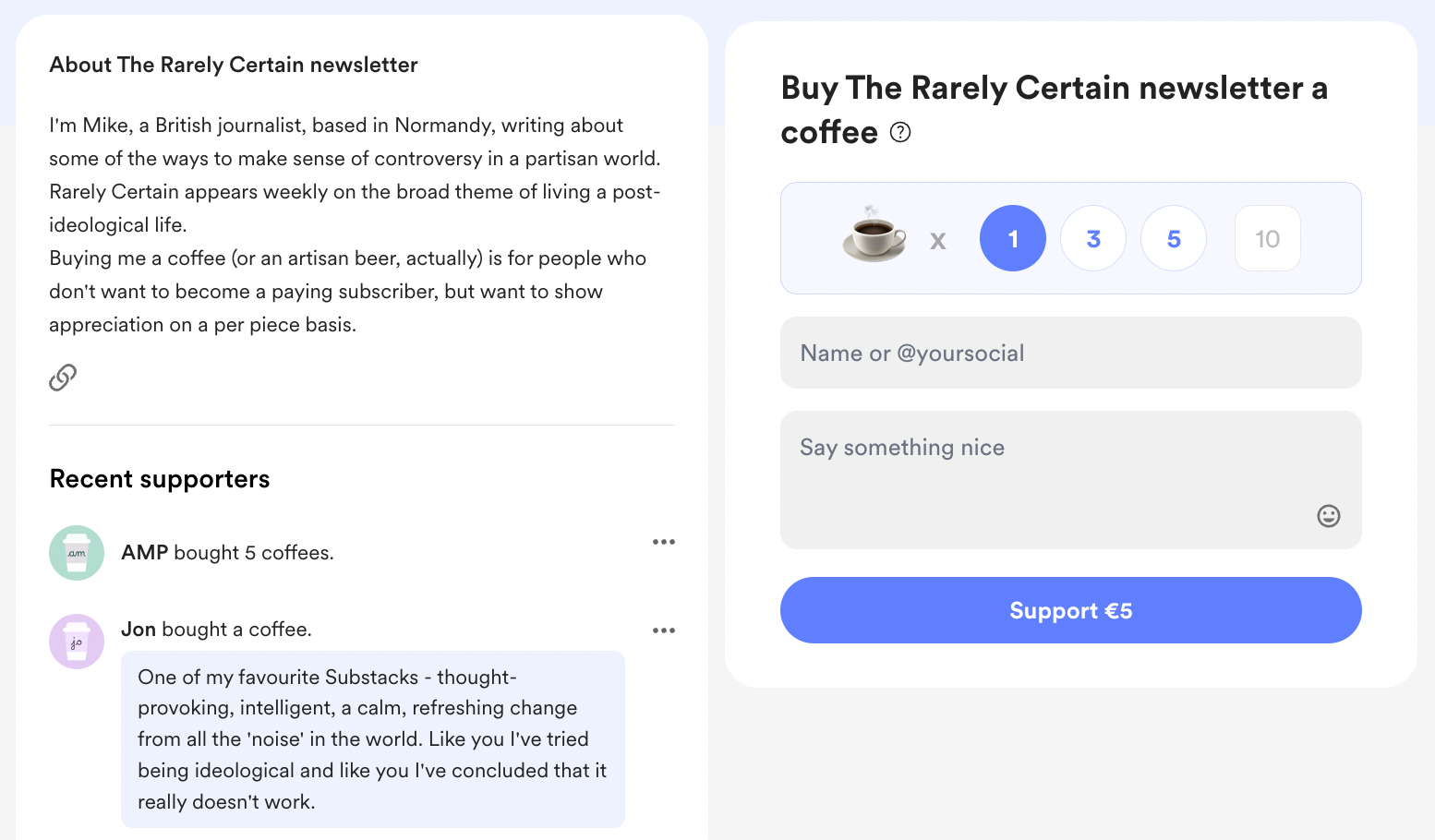
How to get started: sign up for a tool like Buy Me a Coffee and add the link to your newsletter, or incorporate a Whop checkout link to encourage donations. Don’t forget to point subscribers toward the link so they know they have the option to tip you.
2. Affiliate Marketing
If you recommend products, software, or services in your newsletter, you can earn money by taking a slice of commission every time a subscriber buys through your unique affiliate link. The commission you earn depends on the affiliate program, but the more subscribers you have, the better the chances are of someone clicking and buying a product with your affiliate link.
Caveat: not all email providers allow creators to share affiliate links in their newsletters, so double-check that the platform you use is okay with it before you start.
BuzzFeed’s Shopping newsletter links to articles with affiliate links and promotes individual product affiliate links in each edition.
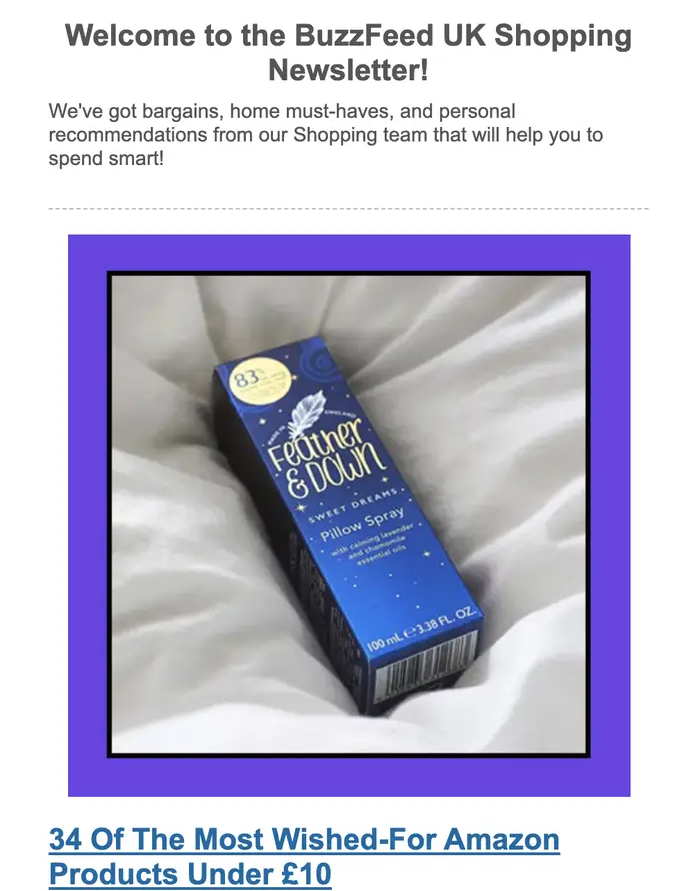
How to get started: choose affiliate programs that serve your audience. For example, promoting a link to a graphic design tool to a bunch of writers won’t get you the best results. Instead, look for products that match the interests and needs of your readership. In this case, it might be a handy writing app or a notebook. You can easily create an affiliate program for your digital product with Whop.
3. Sell Ads and Sponsorships
Charge companies for real estate in your newsletter. Sourcing individual brands and promoting their products or services in exchange for payment is a great way to build industry relationships and earn an income from your newsletter. The best part is, that you can create a tiered pricing structure depending on the ad placement in your newsletter.
For example, you can charge more for an ad at the top as it’s the first thing people will see, or you can charge less for a small mention elsewhere in the newsletter. JavaScript Weekly charges $3590 for a primary advertising slot, while Dense Discovery charges $599 for a main sponsor.

There are two ways that you can find sponsors:
- Seek them out individually and pitch your newsletter.
- List your newsletter on sponsorship sites (like Paved) or create and promote a dedicated sponsorship page.
The former involves slightly more effort on your behalf, but it means you’ll secure ads and sponsors that are highly relevant to your readership. Joining relevant sponsorship sites exposes you to brands that are actively looking to place ads, and having a rate card or a sponsorship page ready to go can speed up the process.
How to get started: make a list of relevant brands you’d like to promote in your newsletter and reach out to them. Alternatively, sign up to a couple of sponsorship sites and list your newsletter for potential sponsors to discover.
4. Create a Paid Newsletter
Paid newsletters work similarly to a membership—subscribers pay a monthly fee in exchange for your newsletter. This is particularly effective for newsletters that offer exclusive content or information that can’t be found elsewhere, like a roundup of daily flight deals or gated interviews.
It can be tricky to convince subscribers to pay for something that might otherwise be free, so it’s important to give them a reason to hand over their cash. I’ve seen newsletters that share weekly job boards, coupon codes, and insider guides do well with this monetization model.
The What to Cook When You Don’t Feel Like Cooking newsletter, run by Caroline Chambers, has a couple of paid options that increase in price. While there is the option to subscribe for free to get monthly recipes, readers can pay £4 a month to receive weekly emails. The newsletter currently has over 150,000 subscribers, so it’s safe to say Caroline probably makes a tidy sum each month.
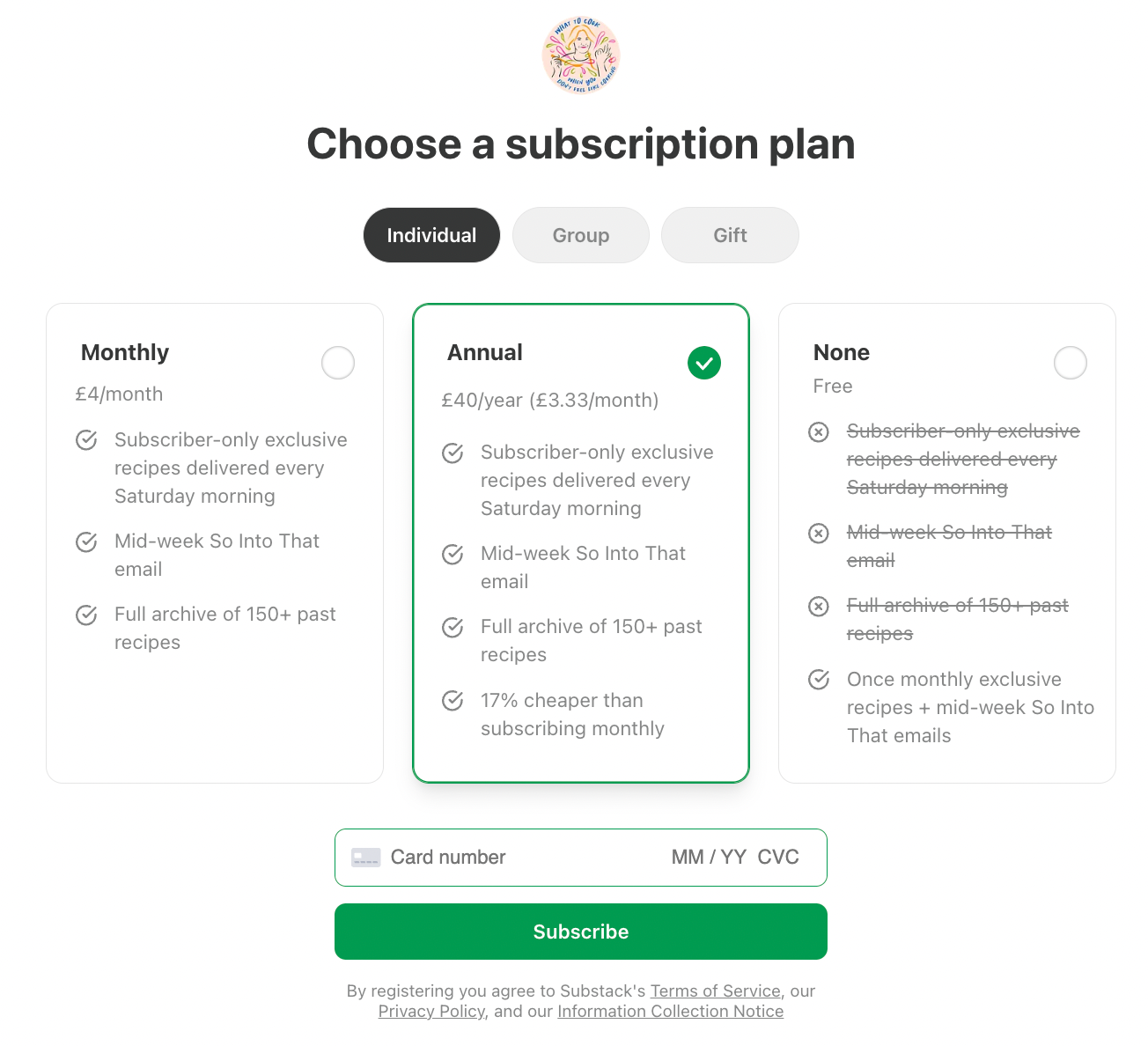
How to get started: it’s hard to get subscribers to pay for a brand-new newsletter with no previous testimonials. Consider running a free version for a while before segueing into a payment model. Alternatively, if you already have a loyal audience like Elna Cain, you can charge from the outset, as long as you’re offering more value than your free products.
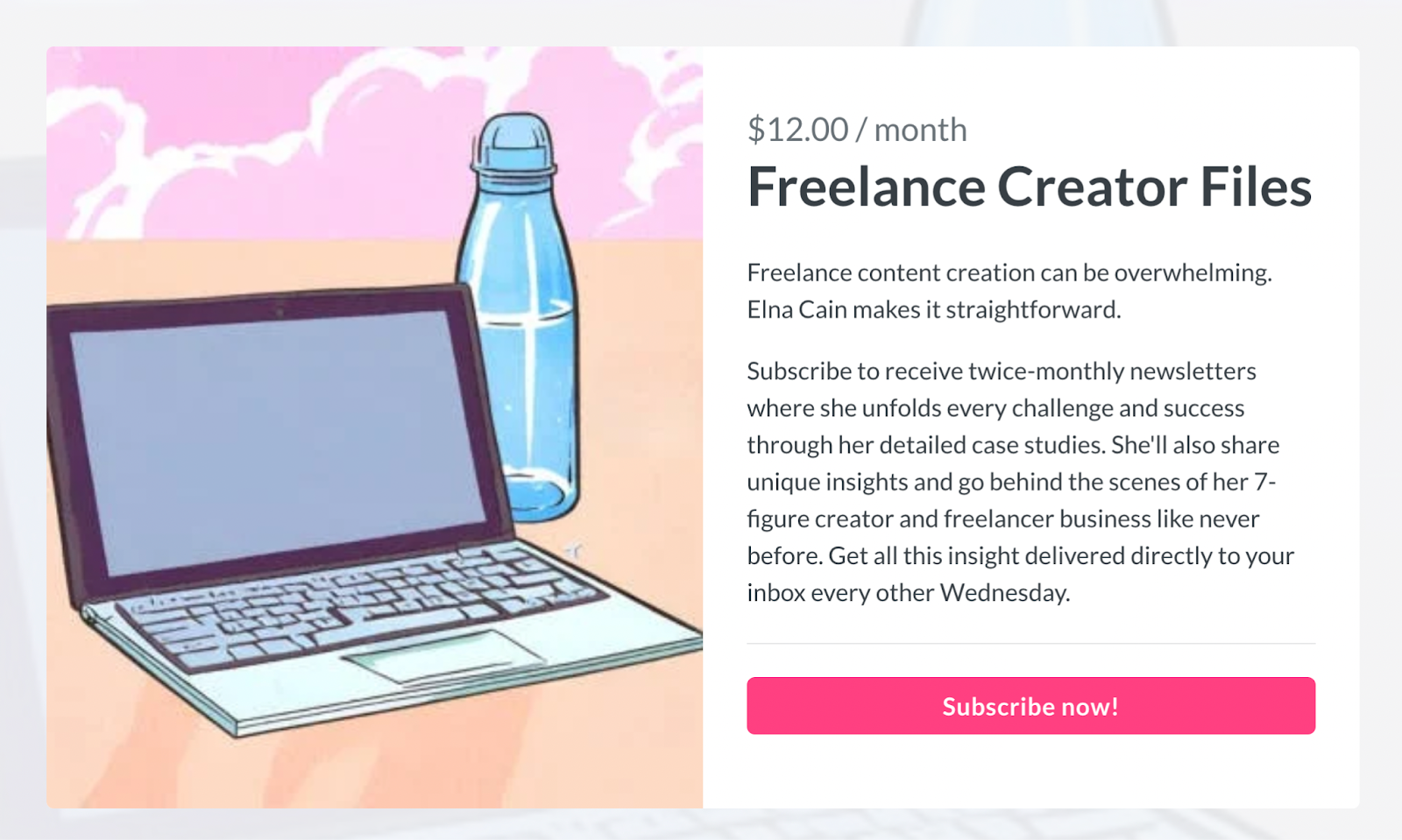
7. Use an Ad Network
If venturing into the wild to find and pitch your own sponsors sounds daunting, you can sign up for an ad network. These work by automatically placing relevant ads in your newsletter so you don’t have to worry about outbound sales. You earn money each time a subscriber clicks on an ad (which might be more often than you think, given the stats I mentioned at the start).
While this is much less time-intensive than selling ad slots on your own, it comes with a downside. You won’t get paid as much as if you were to place ads privately as the cost-per-click is capped. For example, you might make $500 for a sponsored ad placement, whereas an ad network slot might only generate $50 in click-throughs.
Here’s an example of what an ad network placement might look like in your newsletter. You can see it has a “sponsored” tag in the corner. Each time a subscriber clicks “shop now”, you’ll receive a kickback.

How to get started: join a newsletter ad network like Paved or BuySellAds. You’ll be asked to enter some information about your newsletter so the site can match you with relevant advertisers.
- How to Create and Launch Your Very First Newsletter in Only 8 Steps
- How to Monetize a Newsletter (expert advice from an experienced creator)
- The Best Online Newsletter Platforms
8. Sell Digital Products
This is how I make the majority of my newsletter revenue. While I sometimes sell ad slots to relevant brands, I make far more money promoting my digital products to subscribers who are already invested in what I’m offering.
The beauty of a newsletter is you can build a loyal following of people who are primed and ready to buy your stuff. For the best success, ensure your digital products align with the interests and needs of your readership. For example, I sell templates and workshops for freelancers, which works well because my subscribers are predominantly freelancers.
I have a sticky section at the bottom of my newsletter that links to my current list of digital products. I sweeten the deal by offering a discount code for subscribers.
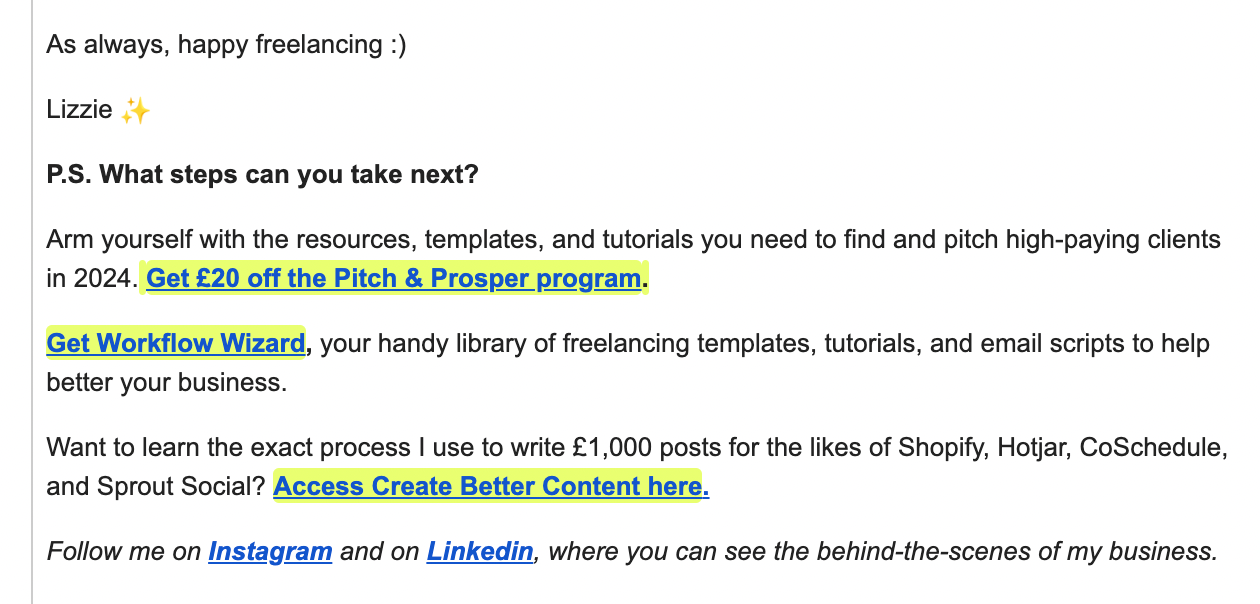
How to get started: you’ll first need some digital products to sell. Survey your subscribers to see what products would be most useful for them. Once created, promote the products in your newsletters. Create an added incentive by offering an exclusive discount for your readers. Then, find a platform like Whop where you can sell all kinds of digital products for low fees.
9. Join a Partner Network
Fancy growing your subscriber base and making money at the same time? It’s possible with a partner network. These programs let you recommend other newsletters to your own audience and pay you for each new signup. It can work the other way around too—you can pay other newsletter creators each time they recommend your newsletter.
For example, the Marketing Letter newsletter uses SparkLoop to pay other creators each time a qualified subscriber signs up.
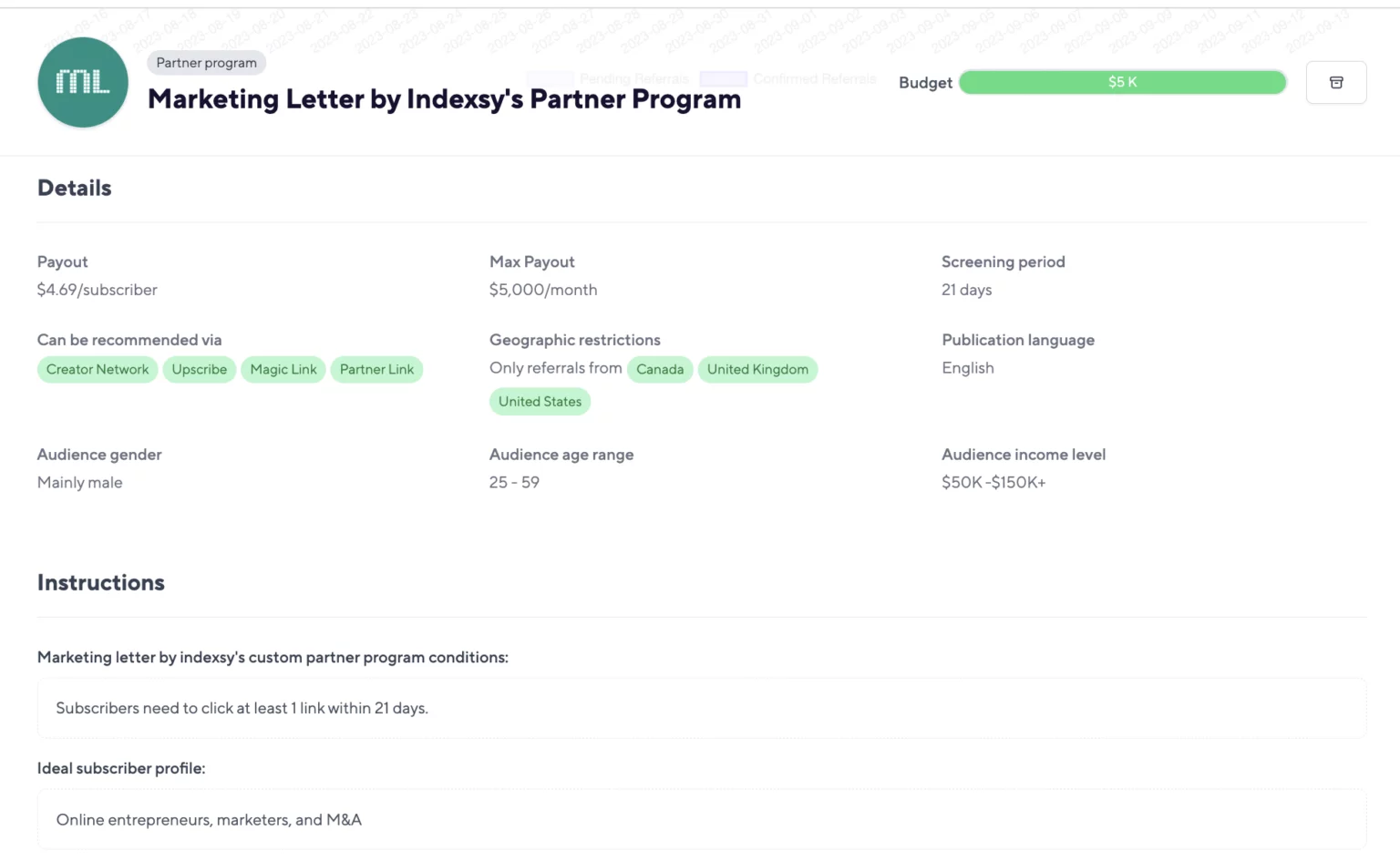
How to get started: research relevant partner networks (like SparkLoop) and sign up for their referral programs. Check the rules for each newsletter, as some will have a strict qualification process—e.g. Only subscribers from a certain country qualify, or they need to demonstrate a certain level of engagement.
10. Create a Membership
Memberships add another layer to paid newsletters. While paid newsletter subscribers might receive two, three, or four more editions per month than free subscribers, paid memberships offer something other than just a newsletter. This might be a members-only online community, access to a library of additional content, or a one-on-one session with you.
Kaitlyn Arford’s Find Freelancing Opportunities newsletter offers three membership levels, including one that offers discounted extras.

Similarly, A Media Operator also offers three membership levels. Free subscribers only get access to the weekly newsletter, whereas premium and VIP subscribers get much more, including a private Slack community, member-only events, and a one-hour consulting call.
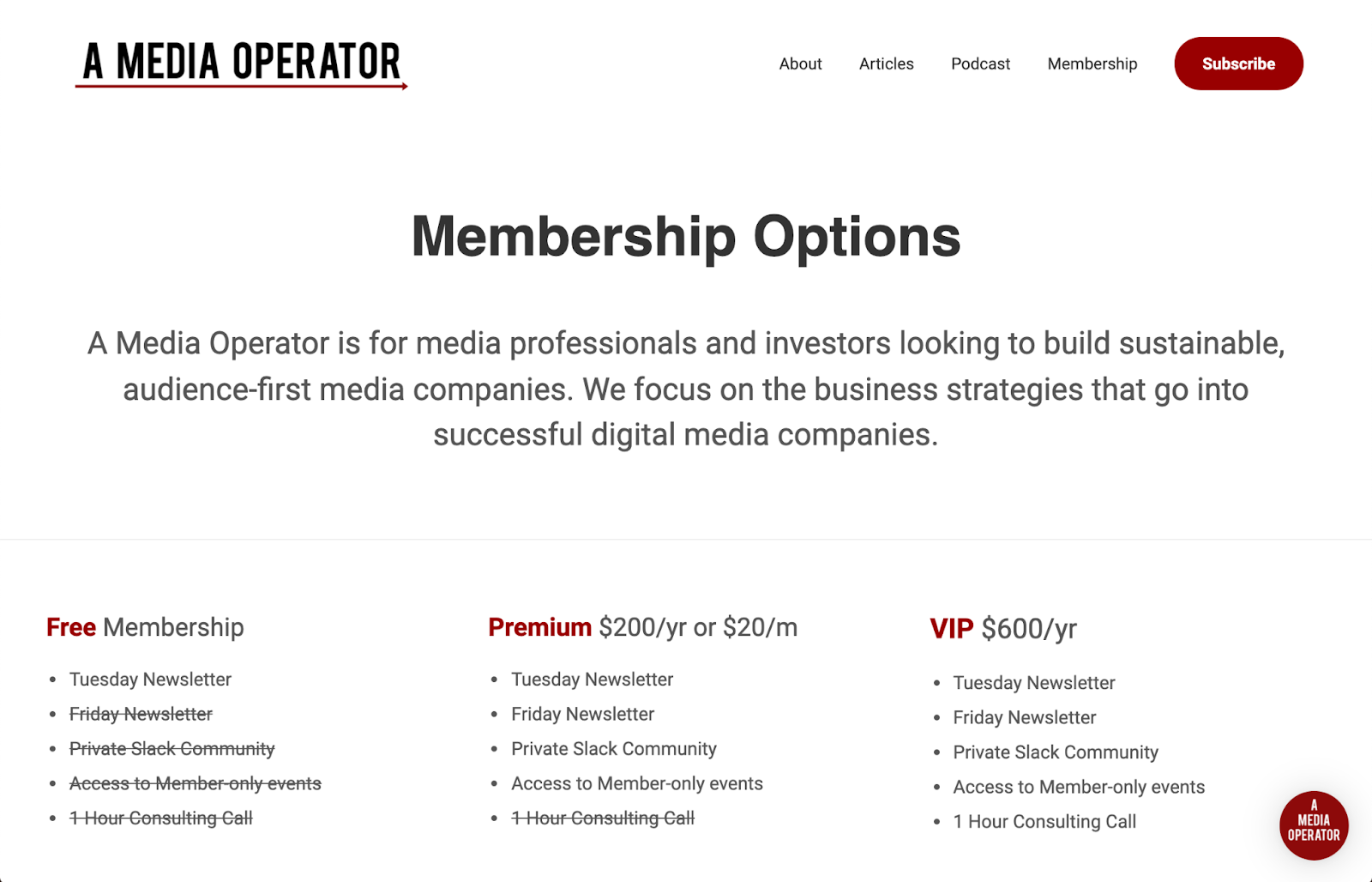
How to get started: consider what added incentives your subscribers will pay for—a members-only community? Access to you? Events? A library of existing content? Then, spread these out among tiers so subscribers can choose what level they want to commit to. With Whop, you can create a hub for your members and include a whole range of perks, like community chat, job board, giveaways, webinars, PDFs, and more - all in one place.
11. Sell Your Newsletter
The final way to monetize your newsletter is to… sell it. This might seem counterproductive, but if you’ve grown a large following, you can demand a decent chunk of cash to hand it over. The Hustle sold its newsletter to HubSpot for over $20 million and there are plenty of creators selling their newsletters on platforms like Duuce and Flippa for four, five, and six figures.
The biggest pro of selling your newsletter is the large lump sum of money. The downside is you no longer own your newsletter so you can’t continue to monetize it in other ways. However, you can apply your learnings (and earnings) to a new newsletter, building it up from scratch until you can sell again.
Here is a list of newsletters up for sale on Flippa with varying asking prices.
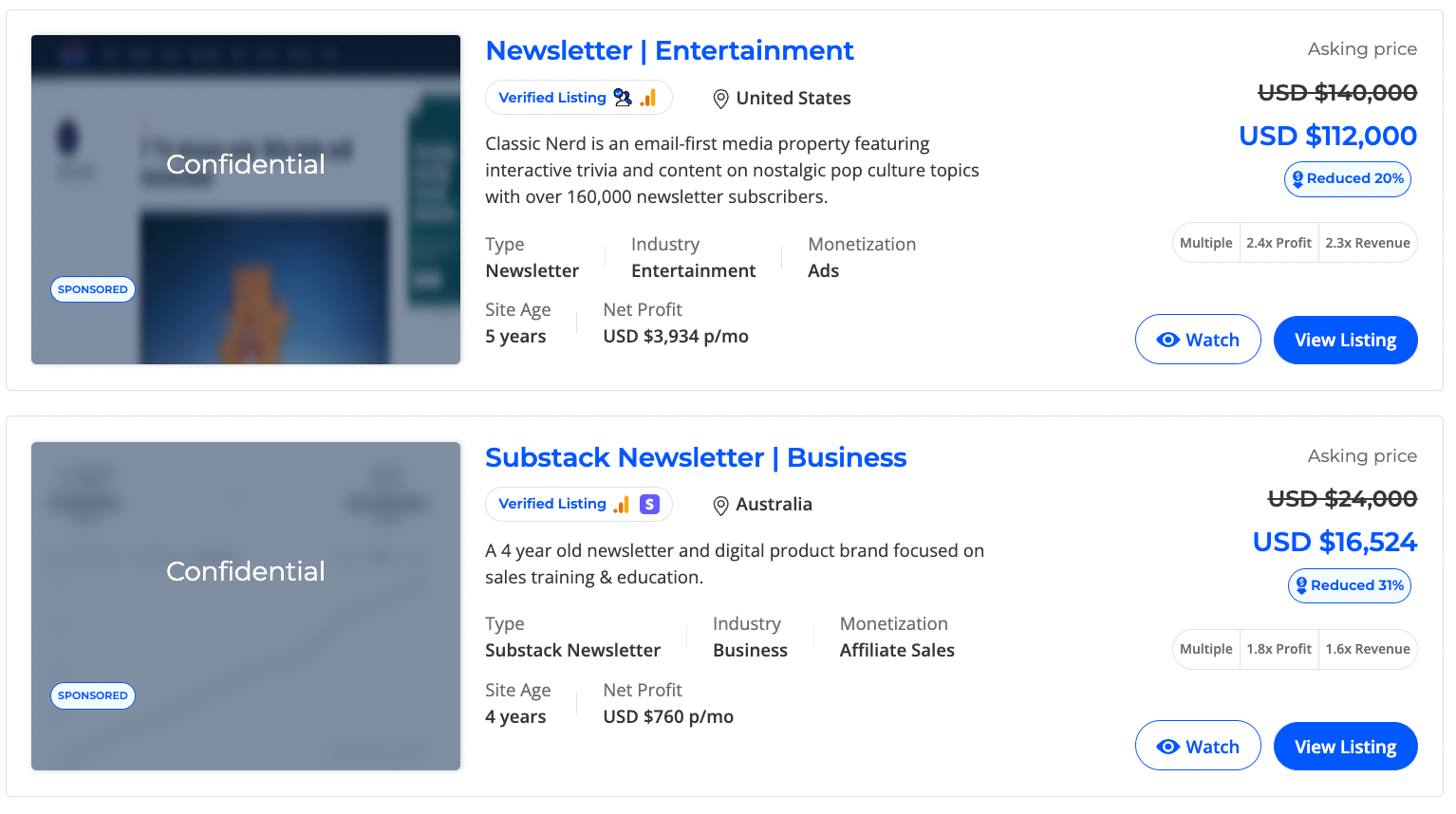
How to get started: You can usually only ask for a certain multiplier of your monthly revenue, so check you’re earning enough each month from your newsletter to warrant selling it. Then, list it on selling sites like Flippa and Duuce to get a feel for any interest.
How Much Money Do Newsletters Make?
The amount you can make from your newsletter will vary wildly depending on your subscriber count, industry, and content. Here are some examples of newsletters and how much money they make.
- Dru Riley’s newsletter, Trends.vc makes him $500,000 a year through memberships and sponsorships. Subscribers can pay $299 a year to receive Trends.vc PRO, while sponsors pay $1,500 per campaign.
- Caroline Chambers has 150,000 subscribers to her What to Cook When You Don’t Feel Like It newsletter which charges £4 a month. If even just a quarter of those are paid subscribers, she’s netting £150,000 a month.
- Tech newsletter Every has a menu of different sponsorship opportunities. It charges $1,000 for an essay sponsorship or $3,200 for inclusion in four newsletter editions.
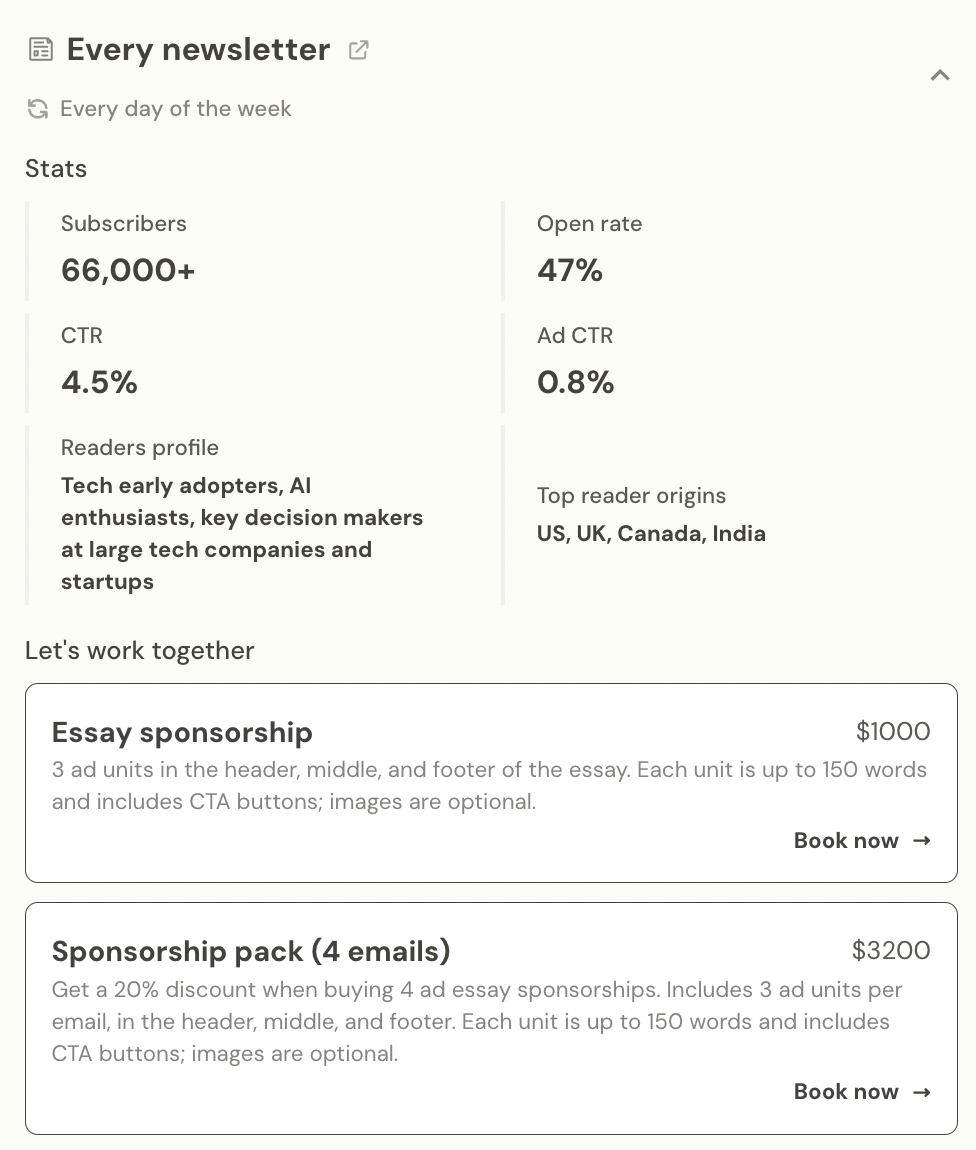
Memberships often charge more than paid newsletters. For example, A Media Operator charges subscribers $20 a month for extras like a members-only community compared to the usual $5-10 for a paid newsletter.
You don’t even need that many subscribers to make money. Danny Gregory makes $45,000 a year from his paid newsletter with just 600 subscribers.
There are no hard and fast stats about how much newsletter creators earn because it’s so varied across different industries. However, research shows that the top 27 Substack newsletters generate a whopping $22 million each year.
Tips For Newsletter Monetization
If you’re ready to start raking in the dollars, here are a few things to bear in mind.
Share Exclusive Content
People aren’t going to pay for something they can readily get for free. Newsletters that make money offer something extra, like additional content, exclusive offers, or access to something that’s otherwise hidden.
This is particularly true if you want to monetize your newsletter by offering a paid subscription. Consider what additional value you’re giving to paying subscribers over those who read for free. For example, Trends.vc’ paid newsletter gives subscribers access to a library of reports, while Caroline Chamber’s paid newsletter subscribers get an extra seven editions each month.
Create Case Studies
Securing sponsorship often involves proving your newsletter can deliver on open rates and engagement. If you’ve worked with brands in the past, consider creating a series of case studies that highlight the results. For example, you can include how many people opened the email, how many people clicked the sponsored link, and how many people went on to purchase a product through your ad.
When a potential sponsor enquires about your offers, you can share these case studies with them for added proof and reassurance.
Katelyn Bourgoin shares testimonials and previous results on the sponsorship landing page for her newsletter, Why We Buy.
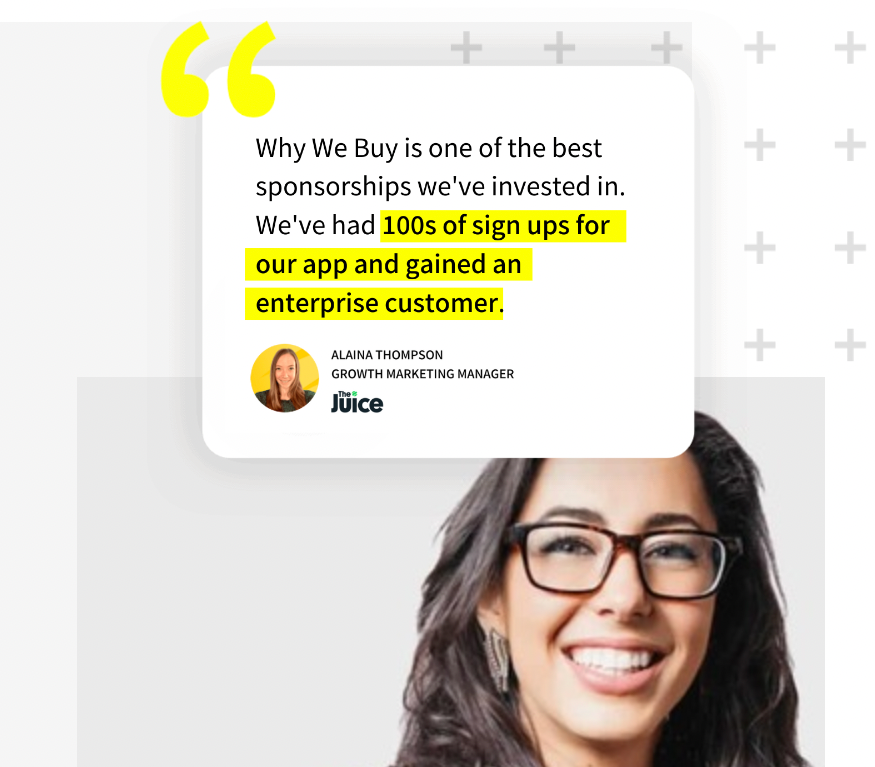
Build a Community
Loyal subscribers are far more willing to hand over their money than subscribers who barely know you. Take the time to build a community around your newsletter by inviting reader questions or creating a space for your audience to communicate. It’s much easier to sell digital products and paid subscriptions to people who trust and admire you.
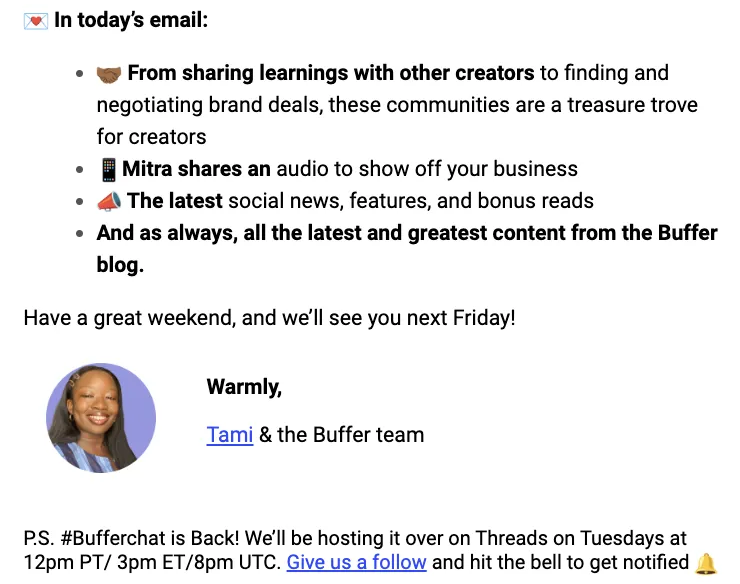
Buffer’s newsletter promotes its Threads community, where it hosts a weekly Q&A chat.
In a similar vein, ParrotStock uses Whop to send out its newsletter and grow a community through interactive discussions.

Offer Discounts and Promos
Thank your subscribers by giving them a discount or deal on your products or services. For example, I offer my newsletter subscribers £20 off my signature course if they buy it through the link in the newsletter. This builds goodwill while earning you extra income.
Listen to Your Audience
Most importantly, listen to what your subscribers want and need from you. If you’re not getting much traction from affiliate links, it might be because your audience isn’t invested in what you’re selling. Take the time to discover who your subscribers are and what they most value from you. I do this by running a yearly survey to ask subscribers what content they enjoy, what they want to see more of, and how they feel about my monetization efforts.
I also check in with my audience every so often to get their feedback. Take this newsletter, for example, where I asked them what type of content they preferred to see in the newsletter. As a result, I could refine my strategy and deliver content my subscribers actually want.
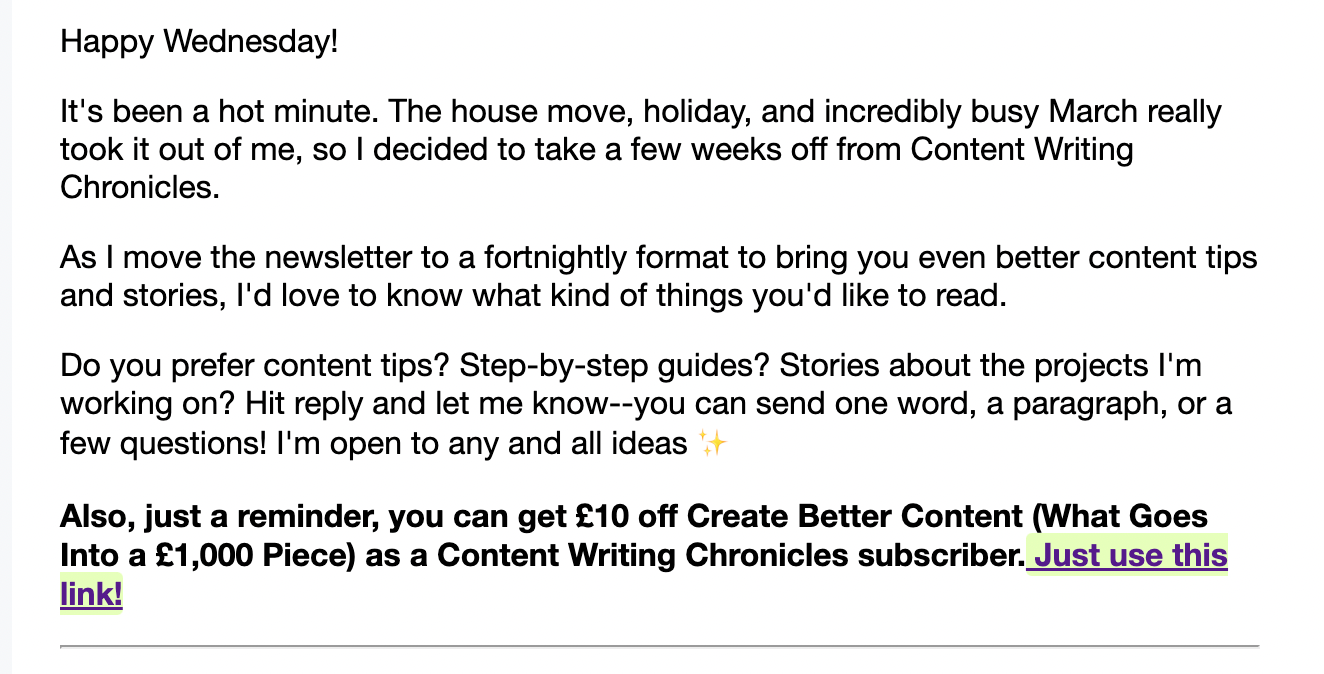
Diversify Your Monetization Efforts
As you can see, there are many different ways you can monetize your newsletter and some may work better than others. For best success, diversify your monetization strategy by using multiple methods at once. For example, you can offer sponsorships, sell digital products, and incorporate affiliate links to maximize your newsletter revenue!
Monetize Your Newsletter With Whop
Whop caters to almost all of these monetization techniques. When you create your whop hub, you can funnel subscribers to your hub where they can access additional content, such as:
- A chat app and forum for community building.
- Giveaways and contests to boost engagement.
- Affiliate content to increase sales.
- Courses to build authority (and make money at the same time).
- Downloadable files, like ebooks and digital products.
Each of these elements is added via an app and you can customize your whop hub to meet the needs of your subscriber base by adding as many or as few apps as you like. For example, you can create tiered memberships to gate certain parts of your hub or add a tip jar to encourage subscribers to donate. Plus, Whop handles payments for you, so you can accept a range of currencies (including cryptocurrencies!) and create one-off payments, memberships, and subscriptions - including tiered options.
With Whop, you can turn your newsletter into a money-making machine by diversifying your monetization options but keeping all of your revenue streams in one place. One platform, one hub, and one low fee of just 3%.
Newsletter FAQs
Do newsletters increase sales?
In short: yes. You can promote your digital products, memberships, and sponsors through your newsletter, all of which can increase sales. As well as using your newsletter as a tool to promote your products and services, you can make money directly through it by sharing affiliate links, joining ad networks, and creating paid subscription tiers.
Is a paid newsletter a good business?
Paid newsletters have the potential to earn you a lot of money. However, the price point tends to be quite low ($5-10 a month) which means you either need a fairly sizeable audience or a very niche newsletter to make a decent amount of money. If you can master that, then running a paid newsletter can be a very good business model because it brings in recurring revenue.
Can you make money from a free newsletter?
You absolutely can make money from a free newsletter. Try securing sponsorships from relevant companies, promoting your digital products, or joining ad networks. You can also sprinkle affiliate links throughout your newsletters if your email platform allows and ask subscribers to donate via a virtual tip jar. I monetize my free newsletter by applying a tempting discount to my digital products that’s only available for subscribers.
How many subscribers do you need to monetize a newsletter?
Obviously, the more subscribers you have, the more money you can make from your newsletter. While many sources will say you need at least 2,500 subscribers to start monetizing, there are plenty of creators making money with much smaller audiences. Take Danny Gregory, for example, who makes $45,000 a year from his paid newsletter with only 600 subscribers.
If you have a small email list, try focusing on high-return monetization strategies like selling digital products and securing sponsorships. You’ll have more success than implementing methods that rely on sheer numbers, like ad network placements and affiliate links.
How profitable are online newsletters?
The value of a newsletter is highly dependent on its subscriber count and industry, but it can be very profitable. Those with tens of thousands of subscribers can make a very decent revenue each month by selling sponsorships, promoting digital products, or simply offering a paid membership.
The profitability of your newsletter will depend on the monetization techniques you use and the size of your audience. Try experimenting with a few different monetization methods to see what works best for you and your audience.
How do 7-figure newsletters make money?
The most profitable newsletters tend to have several revenue streams. They use a mix of sponsorship deals, ads, digital products, memberships, and paid tiers. Most seven-figure newsletters have a considerable amount of subscribers—usually 100,000+, which makes it easier to turn a profit. The more subscribers you have, the more you can charge for ads and sponsors, and the more you’ll get from affiliate programs.
How much does it cost to start a newsletter?
You can start a newsletter for free. Many email marketing platforms offer a free tier if you have less than 500 subscribers. The more subscribers you get, the more it costs, with most tiers increasing in price.
The better (and cheaper) option is to create a Whop. It’s free to start your hub and Whop just takes a 3% fee on sales.




